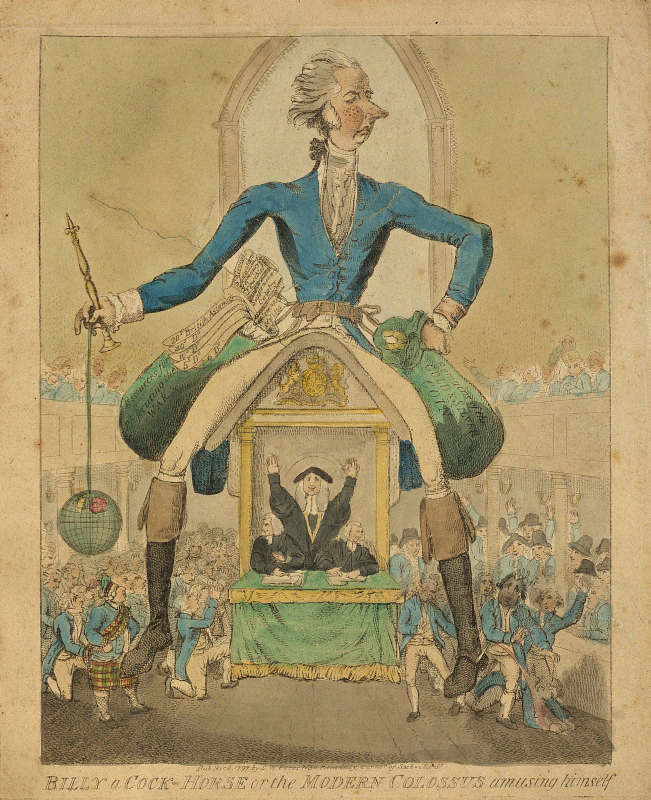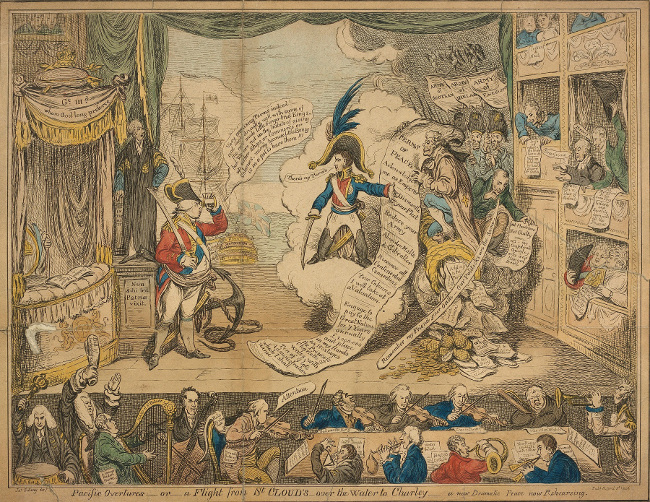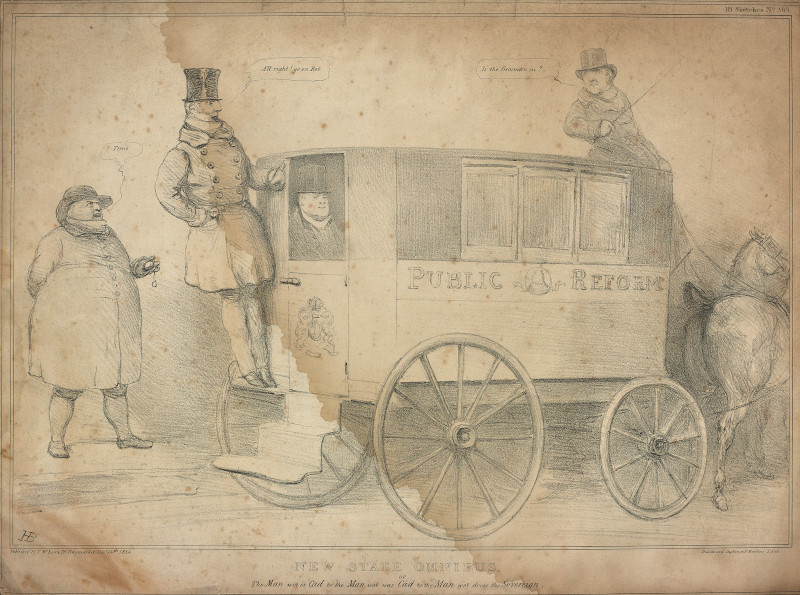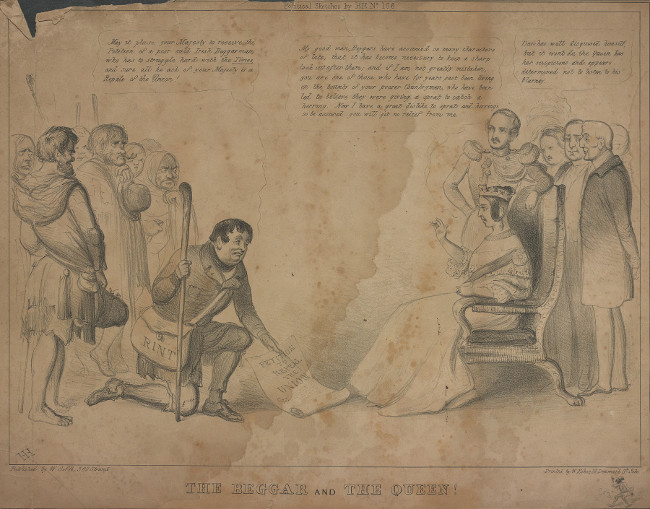Political Prints: A Brief Look at 18th and 19th Century Visual Satire
- John Rooney
- August 19, 2020
Among the Cartographic Visual material currently being listed in Special Collections are two small collections of political prints, each representing two distinct periods in the history of visual satire and caricature in Great Britain.
Napoleonic Prints
The first set, titled ‘Napoleonic Prints’, contains thirteen engravings from the “Golden Age” of the political print (1760-c. 1830), dating from the end of the Seven Years War, in 1763, to the War of the Sixth Coalition during the Napoleonic era – the final print dating from 1813.
A range of social, political and technological factors aided the development of the political print in the latter half of the 18th century, with the medium truly coming into its own during the upheaval of the French Revolutionary and Napoleonic Wars. The period saw the emergence of a number of pioneering artists, including James Gillray (1756–1815), Thomas Rowlandson (1757–1827) and George Cruikshank (1792–1878). Gillray, in particular, is credited with transforming the medium through his distinct style and humour for which he has received the title “the father of the political cartoon”. Most prints at the time were sold as single sheets and produced from etchings or engravings, some using aquatint, while others were hand-coloured.

Members of the royal family, political figures, and other high-ranking members of society were all prime targets for Gillray and his fellow caricaturists, with images highlighting distorted or exaggerated features as the subject’s ambitions and moral shortcomings are mocked and scrutinised. A regular source of inspiration was the bitter rivalry between the Tories and the Whigs. The example above, from 1797, depicts a particularly arrogant William Pitt the Younger in Parliament bestriding the Speaker’s chair as he uses a spur on his left boot to stab Charles James Fox, Leader of the Opposition. The print is one of many focusing on Pitt’s management of finances to fund the war against Revolutionary France.

George III and Napoleon were other popular subjects of ridicule. The former was often depicted as a pretentious fool, while the latter’s political ambitions were satirised, with caricatures emphasising his stature and/or inflated head. The above print by Gillray, from 1806, depicts George III confronting Napoleon on a theatre stage. Napoleon stands on a cloud as he points to a scroll containing his terms of peace. Meanwhile, the orchestra in the pit below is composed of members of the new Ministry, each playing to their own sheet music. As was common, the image is filled with commentary, analogy, and allusion.
Daniel O’Connell Prints
The second set of prints, titled ‘Daniel O’Connell Prints’, contains eleven lithographs, dating from the 1830s and 1840s, and represents the work of two artists: John Doyle (1797–1868), who adopted the monogram H.B., and Henry Heath (fl. 1822–1842), who adopted monogram H.H..
By the 1830s, visual culture had changed, moving from the engravings and etchings of the earlier period to new techniques such as lithography. The new cheaper, and quicker, methods of production coincided with a shift from single sheet prints to serial formats. As Henry Miller notes: “Instead of being issued as single-sheet prints, caricatures, graphic satires and non-satirical political images increasingly came in a variety of formats that were published continually at regular intervals.” (p. 25) Both changes can be found in the set, with each of the prints numbered as part of a series – in the present case ‘Political Sketches of H.B.‘ and ‘Political Sketches by H.H.’.

The John Doyle, or H.B., prints primarily focus on the short period of Robert Peel’s first Ministry (1834-5). The image above reflecting the less than promising start to Peel’s first term as Prime Minster. It depicts an omnibus, lettered “Public Reform”, with the Duke of Wellington as the conductor, or cad, and Sir Robert Peel as the coachman. Unfortunately, it only carries a single passenger in the form of William IV. Meanwhile, John Bull, a personification of the nation, keeps watch as timekeeper. Indeed, Peel’s minority Tory government was forced to resign after approximately a hundred days in office, largely thanks to an alliance between the Whigs and Daniel O’Connell.
Only one of the Doyle’s prints contains the figure of O’Connell. Dating from 1837, it depicts him as the driver of a hackney-cabriolet, titled “Patent Safety”, dictating the direction of the cab and, by implication, the present Whig ministry under Lord Melbourne.

Conversely, Daniel O’Connell appears in all five of the Henry Heath, or H.H., prints which provide a short sequence focusing on his campaign for repeal of the Union. The image above, shows O’Connell kneeling before Queen Victoria disguised as a beggar as he presents the petition for repeal. A group of Irish beggars stand behind him while Prince Albert, Sir Robert Peel, and the Duke of Wellington accompany the Queen. In the dialogue boxes, the Queen indicates that she sees through O’Connell’s disguise and rejects the petition, while Wellington and Peel comment on the matter: “Dan has well disguised himself, but it won’t do, the Queen has her suspicions and appears determined not to listen to his blarney.” The remaining prints focus on O’Connell’s subsequent arrest, trial and imprisonment.
Both sets of political prints are now fully listed, with further details and the complete listings available on the Special Collections’ Cartographic Visual LibGuide.
Bibliography
George, Mary Dorothy, Catalogue of Political and Personal Satires Preserved in the Department of Prints and Drawings in the British Museum, Vol. VII (London : The British Museum, 1942)
McLean, Thomas, An illustrative key to the Political sketches of H.B.,from no. 1 to no. 600 (London : Thomas McLean, 1841)
Miller, Henry, Politics personified : portraiture, caricature and visual culture in Britain, c. 1830-80 (Manchester : Manchester University Press, 2015)
